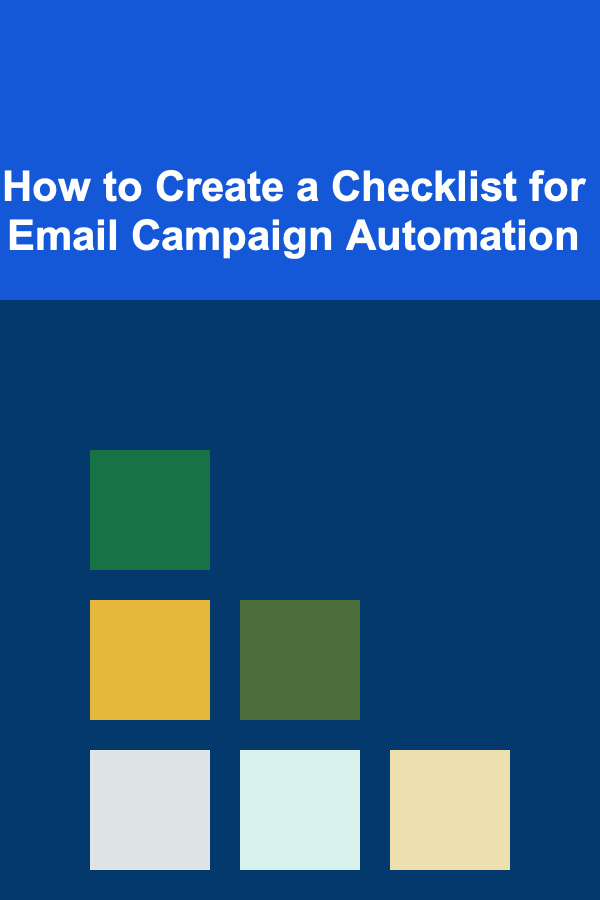
How to Create a Checklist for Email Campaign Automation
ebook include PDF & Audio bundle (Micro Guide)
$12.99$11.99
Limited Time Offer! Order within the next:

Email marketing is one of the most effective and widely used channels for reaching customers, driving conversions, and nurturing leads. One of the best ways to optimize your email marketing efforts is through automation. Email campaign automation allows businesses to deliver personalized, timely, and relevant content to their subscribers without the need for manual intervention. However, creating a successful automated email campaign requires careful planning and organization.
In this actionable guide, we will walk you through how to create a checklist for email campaign automation that ensures you don't miss any crucial steps and can execute a successful email marketing strategy. By following this checklist, you can improve the efficiency and effectiveness of your campaigns, leading to better results and stronger relationships with your audience.
Define Your Campaign Goals and Objectives
The first step in creating any email campaign, automated or not, is to establish clear goals. Without a well-defined purpose, it's impossible to measure success or know whether your automation strategy is working. Your goals should align with your overall marketing strategy and the specific objectives you want to achieve.
Key Considerations for Defining Goals:
- Brand awareness: Do you want to introduce your brand to new subscribers or re-engage inactive users?
- Lead nurturing: Are you trying to guide leads through the sales funnel by providing useful content at key touchpoints?
- Customer retention: Do you aim to increase customer loyalty or repeat purchases through personalized emails?
- Conversion optimization: Are you looking to increase conversions by automating the process of driving users toward a specific action, such as completing a purchase or signing up for a webinar?
Once you identify the main goal, you can break it down into smaller, measurable objectives. For example, if your goal is lead nurturing, your objectives could include increasing the number of sign-ups, improving the open rate, or boosting click-through rates.
Segment Your Audience
Effective email automation relies on sending the right message to the right person at the right time. To achieve this, you must segment your audience based on their behaviors, preferences, demographics, and engagement levels.
Common Segmentation Criteria:
- Demographic information: Age, gender, location, etc.
- Behavioral data: Past purchases, website visits, email interactions.
- Engagement level: Active subscribers, inactive users, or new subscribers.
- Customer lifecycle: Prospects, leads, or loyal customers.
Segmentation allows you to send targeted messages that resonate with your recipients, increasing the chances of success in your campaigns. For example, a new subscriber should receive a different email than a long-term customer.
Choose the Right Email Automation Tool
Selecting the right email automation platform is crucial to the success of your campaign. There are a variety of tools available, each with its own features and capabilities. The tool you choose will depend on your campaign goals, budget, and specific requirements.
Key Features to Look for in an Email Automation Tool:
- Segmentation and targeting capabilities: Ability to create different segments based on subscriber data.
- Email templates and customization: Access to customizable templates for professional-looking emails.
- A/B testing: Ability to test subject lines, content, and CTAs to optimize performance.
- Analytics and reporting: In-depth reporting features that help track metrics like open rates, click-through rates, and conversion rates.
- Integrations: Ensure your email automation tool can integrate with your CRM, e-commerce platform, and other marketing tools.
Popular email automation tools include Mailchimp, ActiveCampaign, HubSpot, and Drip. When selecting your tool, consider your needs in terms of automation complexity, customer support, and scalability.
Design Your Email Workflows
Once you have your audience segments and automation tool in place, the next step is to design your email workflows. A workflow is a series of automated emails triggered by specific actions or events. These workflows can be set up for a variety of purposes, such as welcome emails, abandoned cart reminders, post-purchase follow-ups, and more.
Common Types of Automated Email Workflows:
- Welcome series: A series of emails that are sent to new subscribers to introduce them to your brand, products, and services.
- Abandoned cart emails: Emails triggered when a customer leaves items in their cart without completing the purchase.
- Re-engagement emails: Sent to inactive subscribers to encourage them to return to your site and re-engage with your content.
- Post-purchase follow-ups: Emails sent after a customer makes a purchase to thank them, request feedback, or suggest complementary products.
Workflow Design Best Practices:
- Map out the customer journey: Visualize the entire journey from initial contact to conversion and beyond. This will help you identify key moments where automation can deliver value.
- Set triggers: Determine the actions or events that will trigger an automated email, such as a new subscription, a website visit, or an abandoned cart.
- Determine timing and frequency: Plan the timing of each email in the workflow. How long should you wait between emails? Avoid overwhelming recipients with too many messages in a short period.
- Personalize the content: Use the data you have about your subscribers to personalize emails and make them more relevant. This can include addressing recipients by name, recommending products based on previous purchases, or sending emails at optimal times.
Create High-Quality, Engaging Content
Creating compelling content is the backbone of any successful email campaign. Your emails need to capture your recipients' attention and motivate them to take action, whether that's clicking a link, making a purchase, or downloading a resource.
Key Elements of Engaging Email Content:
- Compelling subject lines: The subject line is the first thing a recipient sees, so make it engaging and relevant. A/B test different subject lines to see what resonates with your audience.
- Personalization: Use personalization tokens such as the recipient's first name, location, or purchase history to make the email feel more tailored to them.
- Clear and concise messaging: Make sure your message is easy to understand and gets to the point quickly. Avoid jargon and long paragraphs.
- Strong CTAs (Call-to-Actions): Your email should have a clear, actionable next step. Make sure your CTA stands out and encourages recipients to take the desired action.
- Visual appeal: Include high-quality images, buttons, and well-designed layouts to make your emails visually appealing. Keep the design consistent with your brand identity.
By crafting high-quality emails, you increase the likelihood of engagement and conversions from your automated campaigns.
Set Up Tracking and Analytics
Once your email automation workflows are up and running, it's time to monitor their performance. Tracking the right metrics is essential to understanding the effectiveness of your campaigns and making data-driven decisions for optimization.
Key Metrics to Track:
- Open rate: The percentage of recipients who open your email. This helps gauge the effectiveness of your subject lines and sender name.
- Click-through rate (CTR): The percentage of recipients who click on a link within your email. This measures the effectiveness of your email content and CTA.
- Conversion rate: The percentage of recipients who complete the desired action (e.g., making a purchase, downloading a resource) after clicking through the email.
- Bounce rate: The percentage of emails that were not delivered to recipients. A high bounce rate could indicate issues with your email list quality.
- Unsubscribe rate: The percentage of recipients who unsubscribe after receiving an email. A high unsubscribe rate could be a sign that your emails are not resonating with your audience.
By regularly reviewing these metrics, you can identify areas of improvement and adjust your campaigns accordingly.
Continuously Optimize Your Campaigns
Email marketing automation is not a "set it and forget it" endeavor. To achieve long-term success, it's important to continually analyze, test, and optimize your campaigns. Regularly testing different elements of your emails (subject lines, content, timing, etc.) allows you to learn what works best for your audience and improve your results over time.
Optimization Tactics:
- A/B test subject lines, CTAs, and email copy: Test different variations of key elements to see what resonates best with your audience.
- Monitor deliverability: Regularly check the health of your email list and ensure that your emails are reaching subscribers' inboxes.
- Adjust workflows based on performance: If certain workflows are underperforming, tweak the timing, content, or triggers to better align with your subscribers' preferences.
- Update email content regularly: Keep your email content fresh and relevant. Review your automated emails periodically to ensure they align with any new products, services, or promotions.
By consistently optimizing your email automation campaigns, you ensure that your efforts remain effective and continue to deliver value to your subscribers.
Conclusion
Email campaign automation can be a game-changer for your marketing efforts, but it requires careful planning and execution. By following this actionable checklist---defining your goals, segmenting your audience, choosing the right tools, designing workflows, creating high-quality content, tracking performance, and optimizing over time---you can create email campaigns that engage your audience, nurture relationships, and drive conversions.
Remember, automation should enhance your marketing strategy, not replace the need for personalized, thoughtful communication. When done correctly, email automation can scale your efforts, allowing you to reach more people with less effort while delivering value at every stage of the customer journey.
Other Products

How to Choose the Perfect Holiday Theme for Your Home
Read More
How to Create a Unique Invitation That Sets the Tone for Your Party
Read More
How to Decorate with Purpose: Choosing Meaningful Pieces
Read More
How to Streamline Your DIY Process with Templates
Read More
How to Track Your Spending with Financial Apps and Tools
Read More